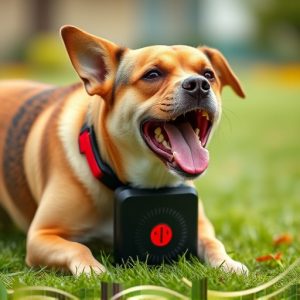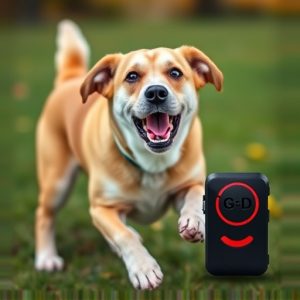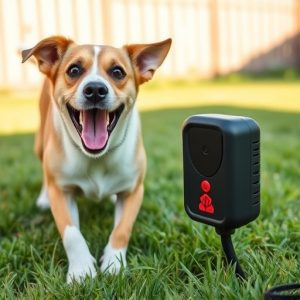Sonic Dog Training: Effective Correction with Vibration Settings
Sonic dog training, or ultrasonic training, employs high-frequency sound waves to correct canine beh…….
Sonic dog training, or ultrasonic training, employs high-frequency sound waves to correct canine behavior through a dog repellent device. The best vibration settings should be tailored to each dog's sensitivity, starting with lower frequencies, aiming to capture attention without causing discomfort. Adjustments based on the dog's progress enhance training effectiveness while maintaining humane practices. Safety and ethics are paramount; consult a vet or trainer for device suitability, and combine its use with positive reinforcement and short, focused sessions.
“Unleash a well-behaved canine companion with the power of sonic dog training, a revolutionary behavioral correction method. This article guides you through the principles and techniques behind this innovative approach, focusing on the safe and ethical use of repellent devices. From understanding the science behind sound waves to choosing the ideal vibration settings for your dog’s device, we provide insights to ensure effective training. Learn how to implement these techniques successfully while adhering to ethical standards.”
- Understanding Sonic Dog Training and Its Principles
- Choosing the Best Vibration Settings for Your Dog's Repellent Device
- Implementing Behavioral Correction Techniques Effectively
- Tips for Safe and Ethical Use of Sonic Dog Training Devices
Understanding Sonic Dog Training and Its Principles
Sonic dog training, also known as ultrasonic dog training, is a modern behavioral correction method that leverages sound waves to communicate with canines. At its core, this approach aims to modify unwanted behaviors by emitting high-frequency sounds that are inaudible to humans but disruptive to dogs. By setting the right vibration levels on a dog repellent device, pet owners can train their furry friends to respond positively to commands or discourage specific actions.
The principles behind sonic dog training are based on the sensitivity of a dog’s hearing and their ability to associate certain sounds with consequences. When used appropriately, these devices can help correct issues like excessive barking, jumping, or running away by providing a gentle but effective deterrent. Key is finding the best vibration settings tailored to your dog’s unique needs and preferences, ensuring the experience is as humane as it is effective.
Choosing the Best Vibration Settings for Your Dog's Repellent Device
When it comes to sonic dog training and behavioral correction using a repellent device, finding the best vibration settings is key to effective yet humane training. Every dog is unique, with varying sensitivities to sound and vibrations. Start with lower frequency settings, as higher ones can be overwhelming for some canines. Gradually increase the intensity if your dog doesn’t respond to the initial level; most devices allow for precise adjustments.
Remember, the best vibration settings are those that prompt your dog to pause, look around, and understand the correlation between their behavior and the subtle yet distinct sound. It should never cause pain or discomfort but rather serve as a gentle reminder to correct unwanted actions. Regularly reviewing and modifying the settings based on your dog’s progress can significantly enhance the overall training experience.
Implementing Behavioral Correction Techniques Effectively
Implementing behavioral correction techniques effectively requires a balanced approach, especially when using tools like dog repellent devices. It’s crucial to set the best vibration settings for your device; too strong a vibration may cause fear or discomfort, while too weak might not be effective. The ideal setting should catch the dog’s attention without causing excessive distress. Always start with lower vibrations and gradually increase if necessary.
Consistency is key. Corrected behavior should be immediately reinforced with positive reinforcement to ensure the dog understands the desired action. Timing is critical; the correction should occur the moment the unwanted behavior starts, followed promptly by a reward for the desired behavior. Using a best vibration setting that doesn’t alarm but alerts your pet can enhance these training sessions, making them more effective and less stressful for both you and your canine companion.
Tips for Safe and Ethical Use of Sonic Dog Training Devices
When using sonic dog training devices, safety and ethics should be top priorities for pet owners. These devices emit high-frequency sounds or vibrations designed to disrupt unwanted behaviors, but it’s crucial to select the best vibration settings tailored to your dog’s sensitivity. Overusing or setting the device too high can cause discomfort, even pain, leading to negative associations and potential health issues. Always consult with a veterinarian or professional trainer to ensure the device is suitable for your dog’s breed and age.
Proper training methods involve consistent, positive reinforcement alongside the sonic device. Use it as a supplement to commands like “leave it” or “stop,” never as a primary punishment. Timing is essential; activate the device precisely when the unwanted behavior occurs. Regular practice in short sessions helps reinforce good habits without overwhelming your dog. Remember, the goal is not just to correct behaviors but also to build a strong bond based on trust and understanding between you and your furry friend.
Sonic dog training, leveraging behavioral correction with repellent devices, offers a modern approach to managing canine behavior. By understanding the principles and choosing the right vibration settings for your dog’s device, you can effectively train while maintaining safety and ethics. Implement these techniques judiciously, always considering your dog’s well-being, and you’ll foster positive changes in their behavior. Remember, the best vibration settings are those that gently correct without causing discomfort, making sonic training a reliable tool for responsible pet owners.


